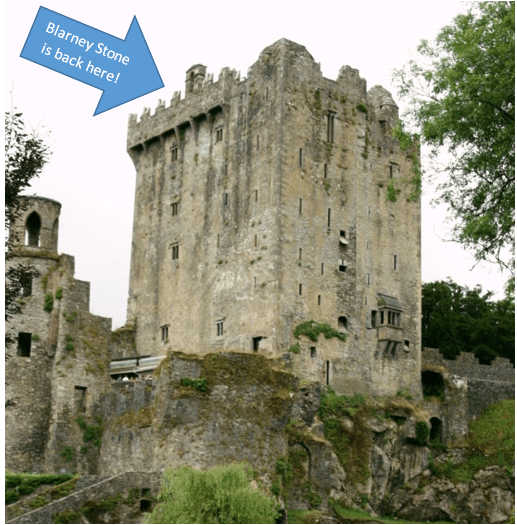
Word of the Day: Blarney
Today’s word of the day, courtesy of the website wordgenius.com, is blarney. The noun means, according to the website, “Talk that aims to charm, pleasantly flatter, or persuade” or “Amusing and harmless nonsense.”
Blarney is the name of a town (population: 2,539) in County Cork, Ireland, a few miles northwest of the port city of Cork, in Southern Ireland. Cork County was the home of the MacCarthy clan, one of the powerful clans in Ireland throughout the Middle Ages. Blarney is a bit of a tourist stop in southern Ireland; people go there principally to see Blarney Castle, which contains the famous Blarney Stone, and the Blarney Woolen Mills.
The Blarney Castle was built in the 1440s by Cormac Láidir MacCarthy, though it is thought that there may have been a wooden structure on the site as early as the 1100s. A stone building was erected on the site around the year 1210, but it was destroyed in 1446, upon which occasion MacCarthy built the current castle.
One explanation for the meaning of blarney, and there are at least a few, involves the castle and a lawsuit that Cormac Láidir MacCarthy was involved in. MacCarthy asked Clíodhna for advice before going to court. Clíodhna, in Irish mythology, was the Queen of the Banshees of the Tuatha Dé Danann, the goddess of love and beauty, and the patron goddess of County Cork. She told him to kiss the first stone he found on his way to court; he did, and the result was that argued his case eloquently and won. Giving credit to the stone, he took it and placed it in the battlements in Blarney Castle. The legend then is that whoever kisses the stone will be given the gift of gab, or the ability to deceive without offending people, or the ability to tell tall tales.
Another tale comes from a bit over 100 years later. Queen Elizabeth of England, at a time when the English “ruled” Ireland, want the various Irish clan chiefs to sign documents indicating that they occupied their lands with her permission. As www.irishcentral.com says, “Cormac Teige McCarthy, the lord of Blarney, was able to use his words and wit to keep the queen satisfied without officially signing over the rights to his land. Some assert that the stone gave Cormac the gift of eloquence after an old woman told him of the stone’s power while others believe no magic to having gone into Cormac’s ability to avoid the Queen’s wishes without offending her.” The situation annoyed her immensely, and “Queen Elizabeth said: ‘Blarney, Blarney, I will hear no more of this Blarney!’” (https://www.reuters.com/article/us-ireland-castle-blarney/irish-stone-of-eloquence-may-be-just-blarney-idUSL2047743820080221).
Here are so more legends about the Blarney Stone, courtesy of the official website for Blarney Castle (https://www.blarneycastle.ie/pages/kiss-the-blarney-stone):
Some say it was Jacob’s Pillow, brought to Ireland by the prophet Jeremiah. Here it became the Lia Fail or ‘Fatal Stone’, used as an oracular throne of Irish kings – a kind of Harry Potter-like ‘sorting hat’ for kings. It was also said to be the deathbed pillow of St Columba on the island of Iona. Legend says it was then removed to mainland Scotland, where it served as the prophetic power of royal succession, the Stone of Destiny.
When Cormac MacCarthy, King of Munster, sent five thousand men to support Robert the Bruce in his defeat of the English at Bannockburn in 1314, a portion of the historic Stone was given by the Scots in gratitude – and returned to Ireland.
Others say it may be a stone brought back to Ireland from the Crusades – the ‘Stone of Ezel’ behind which David hid on Jonathan’s advice when he fled from his enemy, Saul. A few claim it was the stone that gushed water when struck by Moses.
Whatever the truth of its origin, we believe a witch saved from drowning revealed its power to the MacCarthys.
So, if you go to Blarney Castle, you can climb to the battlements and kiss the stone. Like many people over the years, including statesmen from around the world, you may then be given the power of eloquence, though, truthfully, your eloquence may be deceitful.
One example of an American who is famous for blarney is former Vice President Joe Biden. Valerie Richardson, writing in the Washington Times, recounts numerous examples of Biden telling stories that turned out to be tall tales (https://www.washingtontimes.com/news/2020/sep/27/say-it-aint-joe-biden-has-failed-curb-penchant-tal/). For instance, “Last year, Mr. Biden told voters in South Carolina that he ‘got started’ at Delaware State University, a historically Black college. There is no record of his having attended.” On the other hand, Robert Frump, in his blog (https://frumpblog.com/2019/08/30/the-difference-between-bidens-blarney-and-malevolent-malarky/), says there is a difference between Biden’s blarney and “malevolent malarkey.” Frump quotes an anonymous “wise old public relations” person as saying, “But there’s a difference between well-intended blarney and malevolent malarky. Joe may get carried away but it’s all toward a sincere point about something he sincerely believes — and people sense that. On the other hand XXXX just dishes out lies that hide real truths and issues — in other words, he’s full of malarkey.”
It sounds to me as if whether something is benevolent blarney or malevolent malarkey is a matter of personal or political opinion. Elizabeth didn’t think of MacCarthy’s blarney as particularly helpful, but she was a queen, so maybe she cannot be trusted. On the other hand, I can never imagine a situation in which a politician’s lying should be counted as benevolent.
The image of Blarney Castle is from https://www.globalfieldtrip.com/blarney-castle-kissing-stone/. If you ever go there, understand that you have to lie down and lean way out (there are now safety devices to facilitate this) to kiss the stone.